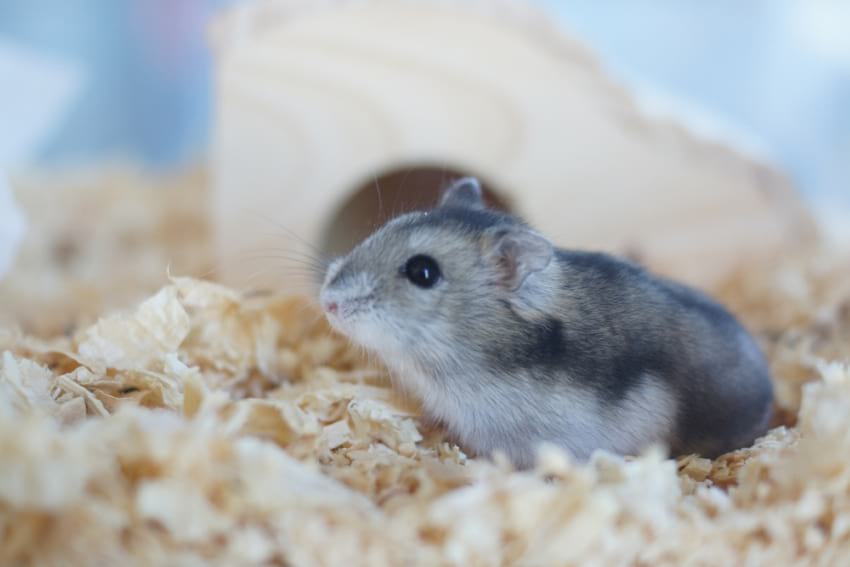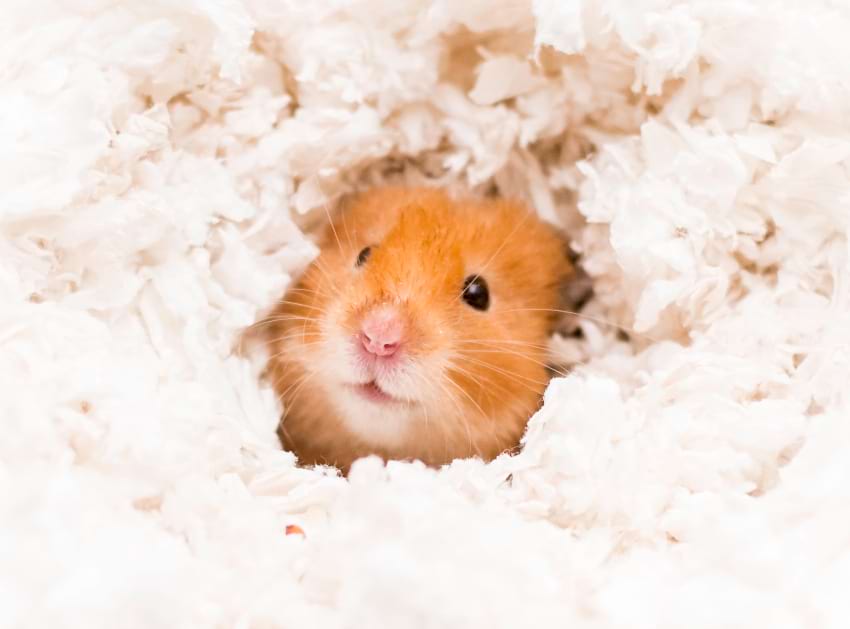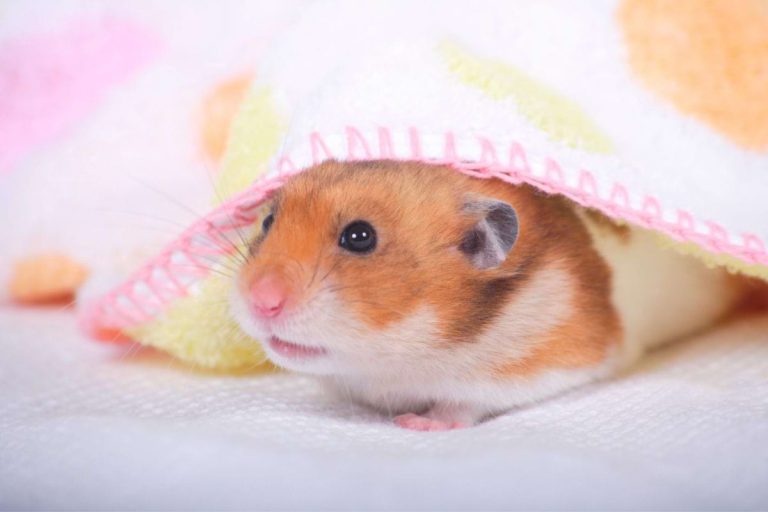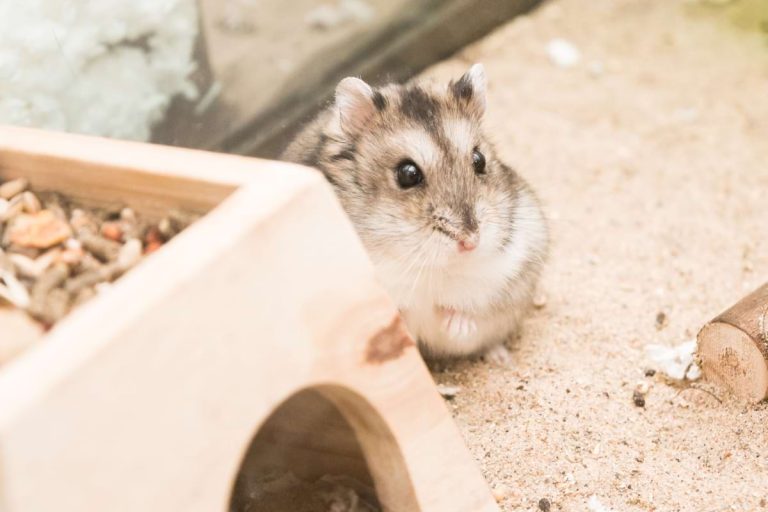How Much Bedding Do Hamsters Need [+ A Calculator]

Hamsters are burrowing animals that live in complex underground burrow systems in the wild. It’s natural for them to create networks of tunnels with nesting and food chambers where they sleep and store food. They even have a dedicated chamber they use as a toilet!
Wild hamster’s burrows are usually between 55 and 65 cm deep (22-26 inches), and while it would be pretty hard for us pet owners to have a cage large enough to fit that much bedding, we can still do our best to provide enough bedding for burrowing.
Providing only an inch or two of bedding won’t allow your hamster to dig and burrow to their heart’s content. Here’s how much bedding they really need.
How Many Inches of Bedding Does a Hamster Need
The minimum depth of the bedding your hamster needs depends on the species of your pet.
Syrian Hamsters
Syrians are the largest hamster species we keep as pets and they grow between 5 and 7 inches (13 – 18 cm) in size, so they need a lot of bedding. Ideally, they should have 12 inches of bedding (30 cm) but don’t go under the minimum of 10 inches (25 cm).
Imagine three hamsters stacked on top of each other. Could you bury them in the bedding? If so, it’s deep enough. If not, add more bedding until the top imaginary hamster is covered.
Dwarf & Chinese Hamsters
For smaller dwarf species and Chinese hamsters, aim for at least 10 inches of bedding (25 cm), but never go under the minimum of 6 inches (15 cm).
By providing enough bedding, your hamster will be able to express their natural behaviors, dig and build burrows which is essential for their well-being. This will also decrease their stress levels and make them less likely to show destructive behavior, such as chewing the cage bars or frantically trying to escape.

How Does Deep Bedding Benefit Hamsters?
Less Stress
Research has found that Syrian hamsters kept with 10 cm (4 in) deep bedding showed significantly more wire-gnawing and a higher running wheel activity than those kept with 40 cm (16 in) and 80 cm (32 in) deep bedding. In fact, Syrian hamsters with 80 cm of bedding didn’t gnaw on wires at all. All hamsters in 40 cm and 80 cm of bedding dug burrows.
So it’s evident that the more bedding you can provide, the better. Your hamster will happily use it to create a comfy underground home.
It Fulfills Their Natural Need to Burrow
As burrowing animals, digging and living in burrows come naturally to hamsters. Underground tunnels are their safe place to hide from predators and feel protected. Even though there might be no predators at your house, your hamster doesn’t know that. If they’re unable to dig and burrow due to a lack of bedding depth, they’ll want to escape the cage to find a new place to build burrows.
Imagine being removed from your house and placed in the middle of the woods for you to live there without any shelter. That is how hamsters feel when they can’t build burrows.
Your Hamster Cage Should Allow Burrowing
As you probably noticed, small hamster cages you can often find in pet stores don’t allow for much bedding. Those small cages are unsuitable for hamsters and are not manufactured with the hamster’s well-being in mind.
I wrote about the minimum ethical cage size for hamsters and some recommended cages that fit the criteria here. If your current cage is too small and can’t fit enough bedding, I highly encourage you to switch to one that can. Your hamster will be a lot happier.
A metal barred cage should have a deep base of at least 6 inches (although more would be better) to allow for the minimum amount of bedding. You can also add a deep digging box to compensate for the lack of bedding at the bottom of the cage.
If you’re going to use an aquarium or a plastic bin, those can hold plenty of bedding but make sure it is high enough to fit a large enough wheel for your hamster on top of the deep bedding.
If you’re using a long but short cage, such as the DIY Ikea Detolf cage, you can fill one side of the cage with bedding to the top and leave the other part of the cage for a wheel and a sand bath.

What to Use as Hamster Bedding
We’ve gone into more detail about the different types of safe bedding you can use in our hamster bedding post. An important thing to remember is that not all bedding types are safe or optimal to use.
Make sure the bedding you use is:
- Non-dusty
- Non-scented
- Safe for hamsters (safe if ingested, no toxins)
- It can hold burrows well and won’t collapse when your hamster is digging.
Safe and most popular options for hamster bedding are:
- Paper bedding such as Kaytee Clean & Cozy or Carefresh
- Aspen wood shavings such as Niteangel shavings
You can use paper bedding and aspen shavings together to provide two different textures. Depending on the product, some aspen shavings might not be great at holding burrows, so I suggest mixing it with paper bedding or hay to improve burrow stability.
You can also provide a ‘booster’ on top of the main substrate in the form of long-strand soft hay. Hamsters love to use it for nesting.
Bedding types to avoid:
- Cedar and pine shavings – these types of wood contain dangerous phenols. While manufacturers started heat treating pine to remove the dangerous phenols, it’s still best to avoid it altogether since hamsters are in such close contact with their bedding and spend hours burrowed in, especially with so many better and safer bedding options.
- Fluffy cotton bedding – there’s a risk of internal blockages if your hamster ingests some of the bedding, and hamster’s limbs can easily get entangled in this type of bedding.
Materials that are safe but not suitable as the main bedding:
- Paper pellets – pellets should not be used as the main bedding as they don’t hold burrows.
- Soft granule bedding – this can be added to your hamster’s cage to add variety but shouldn’t be used as the main bedding as it also doesn’t hold burrows.
- Toilet paper – toilet paper is a great nesting material but doesn’t provide odor control, so it’ll have to be replaced daily.
How to Calculate How Much Bedding You Need to Buy
Now that you know how much bedding you need for your hamster, it’s time to do some math so you can get the right amount of bedding. When looking at the product packaging, it can be hard to figure out how much bedding exactly you need for your cage, especially when it’s compressed inside.
Here’s how to calculate how much bedding you need (or use our calculator below):
- First, calculate the size of your cage in square inches by multiplying cage width by cage length. For example, your cage is 36″ x 18″ which comes down to 648 square inches.
- Now, multiply the square inches of your cage by the wanted depth of your bedding, for example, 10 inches. That’s 648 (square inches) x 10, which makes 6480 cubic inches.
- Since bedding size is displayed in liters, you need to convert cubic inches to liters. To do that, multiply the cubic inches by 0.016387. The result will give you the number of liters you need to be able to fill your cage with 10 inches of bedding.
Paper bedding is usually tightly packed, with the expansion volume listed on the packaging. Keep in mind that the bedding expands to that volume when fluffed up. However, when using it for a hamster, we press the bedding down so it can hold burrows. So when purchasing paper bedding for your hamster cage, double up the amount so you don’t run out of it when setting up a cage.
I’ve created a calculator below to make it easier for you.
Hamster Bedding Calculator
Enter cage width and length and the desired bedding depth in inches or centimeters and the calculator will tell you how many liters of bedding you need.
Remember, if you’re using paper bedding, you’ll need a double amount than what is listed as the expansion volume on the packaging. For example, if you need 100 liters of bedding according to this calculator, buy at least 150-200 liters so it gets to the desired volume when you press it down and make it compact.
Deep Bedding = Happier Hamster
Deep bedding is an essential part of your hamster’s cage and possibly the most important one. It allows hamsters to express their natural behaviors of digging and building burrows, while providing them a sanctuary where they feel safe. This aspect of hamster husbandry is critical for both their physical and mental health.
If your hamster is showing signs of stress, gnawing on the cage bars and constantly trying to escape, rethink your cage setup and bedding depth. Provide your hamster with at least 10 inches of bedding (12 inches for a Syrian hamster), if not more. If the minimum amount of bedding can’t fit inside your current hamster cage, that means the cage is unsuitable for your pet and should be upgraded to something bigger.






